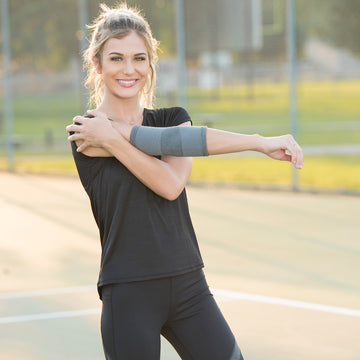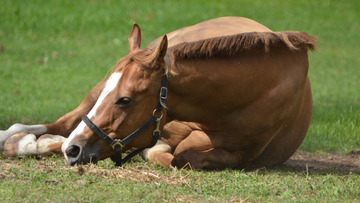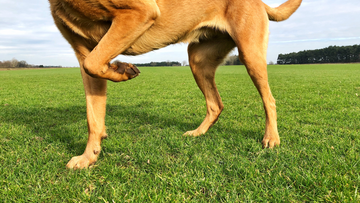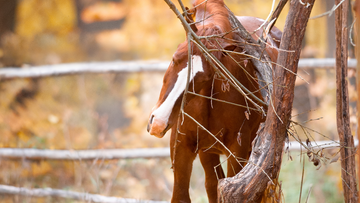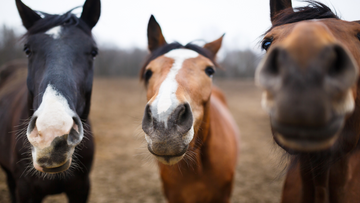
A horse that is scared can be a dangerous animal. By instinct, horses are “flight” animals meaning that they will run from intimidating and threatening situations rather than “fight.” The best way to deal with a horse that is scared is to desensitize them. Desensitizing your horse can seem like a daunting task but it will help your horse gain confidence in not only things around them but also in you. This doesn’t necessarily have to be done with young horses, it can be done with horses of any age.
First things first, the ground rules:
1. Always put your safety first – If you ever feel like you are in danger, dismount from your horse then work the horse on the ground until he is comfortable.
2. Take it easy – Don’t rush your horse into new things. Continue at a pace that helps your horse succeed rather than forcing him.
3. Don’t do this alone – Because desensitizing a horse can be dangerous, make sure you have a friend nearby to keep an eye on you just in case things go awry.
4. Take your time – Be patient with your horse. This is an on-going process.
Keep in mind the basics:
1. Keep a positive attitude – The way you are feeling and react to your horse has a direct impact on their attitude. If you walk up to obstacles like “no big deal” your horse will feel the same. If he can sense your nervousness and worry then he will feel the same way. Always stay positive and calm.
2. Use the pressure and release method – When asking your horse to do something they aren’t comfortable with, use pressure to push them forward. Once they respond to that pressure and move forward, release the pressure and reward him.
3. Sense of smell – Let your horse use his sense of smell and allow him to smell the different obstacles in front of him. This is part of the acceptance process. If he smells it and seems satisfied then you can continue to ask him to move forward with the obstacle.
Technique:
1. When introducing your horse to a new obstacle, start from the ground until he seems comfortable. Be confident but firm with your horse but also be careful not to force or pressure him causing tension with the obstacle. The more your horse gets worked up the less learning he will do.
2. Desensitize your horse’s entire body from head to feet and everything in-between. You can use various objects that might seem “scary” and rub them all over his body until he feels comfortable with it. You can use things like a grocery bag, an inflatable toy, garbage bags, tarps, etc. Take your time with this as it can be scary for your horse initially.
3. Once your horse is comfortable with an object, ride over it. Start out easy with your horse by simply walking over the obstacle. As your horse progresses, you can up the difficulty by trotting over them.
4. Once your horse has been desensitized quite a bit, you can really put his learning to the test. Create an obstacle course for your horse. Use your imagination! You can collect items such as inflatable toys, tarps, plastic bags, blankets, flags, pool toys, balls, cones, road signs, lights, drums, etc. Again, always take your time but this obstacle course will really test your horse’s confidence!
Desensitizing your horse will take time but it is totally worth it in the long run. A horse that is desensitized with be a safer and more confident partner for you.
For more information on desensitizing your horse, click
here.
 A horse that is scared can be a dangerous animal. By instinct, horses are “flight” animals meaning that they will run from intimidating and threatening situations rather than “fight.” The best way to deal with a horse that is scared is to desensitize them. Desensitizing your horse can seem like a daunting task but it will help your horse gain confidence in not only things around them but also in you. This doesn’t necessarily have to be done with young horses, it can be done with horses of any age.
A horse that is scared can be a dangerous animal. By instinct, horses are “flight” animals meaning that they will run from intimidating and threatening situations rather than “fight.” The best way to deal with a horse that is scared is to desensitize them. Desensitizing your horse can seem like a daunting task but it will help your horse gain confidence in not only things around them but also in you. This doesn’t necessarily have to be done with young horses, it can be done with horses of any age.

 A horse that is scared can be a dangerous animal. By instinct, horses are “flight” animals meaning that they will run from intimidating and threatening situations rather than “fight.” The best way to deal with a horse that is scared is to desensitize them. Desensitizing your horse can seem like a daunting task but it will help your horse gain confidence in not only things around them but also in you. This doesn’t necessarily have to be done with young horses, it can be done with horses of any age.
A horse that is scared can be a dangerous animal. By instinct, horses are “flight” animals meaning that they will run from intimidating and threatening situations rather than “fight.” The best way to deal with a horse that is scared is to desensitize them. Desensitizing your horse can seem like a daunting task but it will help your horse gain confidence in not only things around them but also in you. This doesn’t necessarily have to be done with young horses, it can be done with horses of any age.

